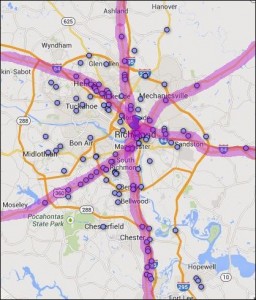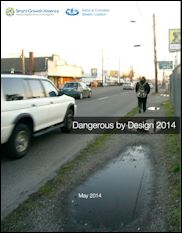In the decade between 2003 and 2012, more than 42,000 pedestrians died on American streets and roads. That’s more than 16 times the number that died in earthquakes, floods, hurricanes and tornadoes. While natural disasters attract national attention, pedestrian fatalities are buried in the back pages, if they’re noted at all, even as the incidence of pedestrian deaths has spiked in recent years.
Pedestrian accidents are far from inevitable, however. Thousands of fatalities along with untold injuries can be mitigated by street design adapted less to the needs of automobiles and more to the needs of people, contends the National Complete Streets Coalition, a program of Smart Growth America, in a publication released Monday, “Dangerous by Design 2014.”
Vehicle speed was a major factor in the pedestrian fatalities. “Where the posted speed limit was recorded, 61.3 percent of pedestrian fatalities were on roads with a speed limit of 40 mph or higher,” states the study. “This figure compares to just 9 percent of fatalities that occurred on roads with speed limits less than 30 mph.”
Sunbelt communities top the list of the most dangerous places to walk in the country. “These places grew in the post-war period, mostly through rapid spread of low-density neighborhoods that rely on wider streets with higher speeds to connect homes, shops and schools — roads that tend to be more dangerous for people walking.”
Orlando, Tampa-St. Petersburg, Jacksonville and Miami-Fort Lauderdale — all Florida metros — nail down the top four spots in the study’s ranking, which compares the number of pedestrian deaths per 100,000 population and adjusts by the percentage of people who walk to work. Among the 51 largest metro regions in the country, Richmond scored the 19th highest Pedestrian Danger Index, with 1.32 annual pedestrian deaths per 100,000 in 2003-2012. Washington ranked 35th and Hampton Roads 36th.
“We can build and design our communities to protect us while walking,” said Stefanie Seskin, deputy director of the National Complete Streets Coalition in a conference call releasing the report yesterday. “Treat city streets like city streets, not like highways. … Auto-oriented streetscapes are not only uninviting and uninspiring but downright dangerous.”
 Local government officials need to distinguish between streets, which function as public spaces accommodating people, cars and bicycles alike, and roads, which function mainly for the movement of cars at higher speeds. The greatest threat to pedestrian safety occurs in street-road hybrids (stroads), typically commercial strips where people intermix with cars traveling at fairly high speeds. The map of the Richmond region at left shows the concentration of pedestrian fatalities in the region’s major stroad corridors: Broad Street, Midlothian Turnpike and Rt. 1. The peculiar mix of retail, restaurant and office activity along these corridors induces people to walk across streets ill suited to pedestrian traffic with frequently tragic results.
Local government officials need to distinguish between streets, which function as public spaces accommodating people, cars and bicycles alike, and roads, which function mainly for the movement of cars at higher speeds. The greatest threat to pedestrian safety occurs in street-road hybrids (stroads), typically commercial strips where people intermix with cars traveling at fairly high speeds. The map of the Richmond region at left shows the concentration of pedestrian fatalities in the region’s major stroad corridors: Broad Street, Midlothian Turnpike and Rt. 1. The peculiar mix of retail, restaurant and office activity along these corridors induces people to walk across streets ill suited to pedestrian traffic with frequently tragic results.
The same pattern prevails across the state. Stewart Schwartz, executive director of the Coalition for Smarter Growth, cited the example of an elementary school principal in Loudoun County who was killed last year trying to cross a four-lane, 35 mph road. “As more people make the sustainable and healthy choice to leave their cars at home, we are unfortunately seeing more tragic crashes,” he said in a press release yesterday. “Decades of car-oriented design has made it hazardous in many of our communities simply to walk to school, work, or shopping.”
What public policy approaches are available to curb the incidence of pedestrian deaths? One option, pursued most vigorously in Florida, is to step up education and police enforcement of speed limits and laws that require cars to yield at crosswalks. A less authoritarian approach is to alter street design. There is a pervasive body of thought that wide roads, wide lanes and the absence of visual cues induce motorists to drive faster than posted speed limits. Proper design discourages pedestrians from attempting to cross high-speed roads and encourages cars to drive much slower on people-friendly streets.
Public officials need to think of “streets as public realm, not as right of way,” said Steven Spears, a principal with Design Workshop landscape architects, who designed the conversion of the Bagby Street corridor in Midtown Houston into a more pedestrian-friendly street.
The Complete Streets movement advocates such tactics as installing on-street parking to create barriers between pedestrian and automobile traffic, reducing lane widths, rounding corners to make cars slow down when they turn, and improving crosswalks. Often, roads can be transformed into streets without adding to right of way simply by converting space dedicated to cars into space for sidewalks or bicycle lanes.
“For many years, we built wider and wider streets throughout the region that encourage speeding and are incredibly dangerous for pedestrians to navigate. We’re now finally moving towards designs that make it safe for everyone – pedestrians, cyclists, and drivers – to use our roadways,” said Brianne Mullen, Executive Director for the Partnership for Smarter Growth in Richmond.
Schwartz and Mullen cited the example of Lawyers Road in Reston, where in 2009 the Virginia Department of Transportation converted a two-mile stretch from four car lanes (two each way) to three (one each way, and one for left-hand turns) and two bicycle lanes. VDOT also reduced the speed limit from 45 mph to 40 mph. A large majority responding to a survey said the changes had improved the road. People felt safer, bicycled more and said that car travel times had not increased.
Putting roads on a “road diet” is one of the less expensive improvements that public officials can do. The trick is to proceed in steps. First, reconfigure lane widths and road designs with striping and inexpensive materials. If the experiment doesn’t work, the road can be readily returned to the way it was. If citizens respond favorably, proceed with more permanent improvements. Ideally, many changes can be paid for with funds dedicated to routine maintenance and repairs.
Complete Streets provide another payback: higher property values. People pay a premium to live in work in walkable neighborhoods. For example, Houston’s Bagby Street project netted a 20% increase in property rents and attracted $30 million in new investment.
“Walkable communities are much in demand in Virginia based on the revival of our cities and towns,” said Schwartz. “Unfortunately, many traffic engineers push back against communities, elected officials, and smart growth developers who want to create the walkable neighborhoods so much in demand today. The good news is the VDOT has a ‘complete streets’ policy, as do a number of local jurisdictions, so it is our hope that VDOT and local transportation planners would team up to make more of our arterials and streets safer for pedestrians.”



